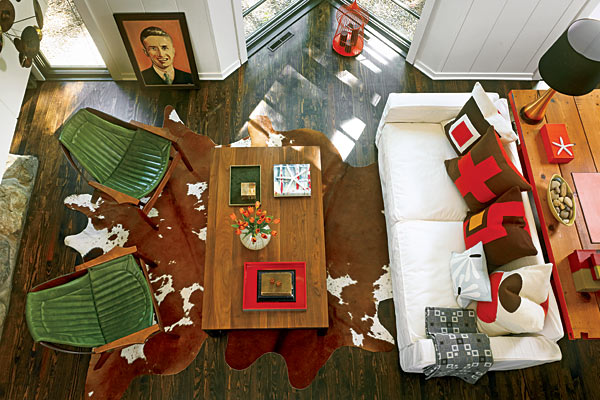
To add more light to the living room, floor-to-ceiling windows were added on both sides of an original bay window. The old kitchen door was given a coat of orange paint around its rim and set on sawhorses to become a desk (behind the sofa). Photo Gallery »
It took Deanna and David Stallsmith mere minutes to know they had found their new weekend home when their real estate broker showed them a ramshackle, half-log cabin in Michiana in 2003—despite its depressingly dark, kitsch-crammed interior. Their chief desire was “to walk into a place and be in a great room,” says David, and the cabin, built in the 1930s, filled that bill.
They also wanted open, light-filled spaces inside and out. With a warren of rooms surrounding the two-story living room, mud-brown cedar paneling, and only a tiny deck, the house was still lacking. But “we could immediately envision what it would look like with the knickknacks gone and everything painted white,” Deanna says.
The Stallsmiths had a strategic game plan. Before gutting the place, “we decided to live here a few years to get a sense of what we really wanted to do,” Deanna explains. They did pull off some quick fixes right away, blitzing the place in ten days with the help of David’s father, a professional carpenter. Out went the 1950s kitchen and in went interim cabinets from Lowe’s, and countertops from Ikea, high-end stainless steel appliances they planned to keep long-term, and white paint on the paneled walls. “Five coats, to be exact,” says Deanna. “Afterwards, it looked like the lights had been turned on.”
Four years later, in 2007, “they told us they wanted to add something new to something old,” recalls architect John Hancock, who undertook the full-scale renovation project with interior designer Nina Hancock, his wife and business partner. Structurally, the house had some issues—its framing had to be shored up to level the floors; it also needed new windows, roofing, and split-log siding.
To make the house feel more spacious and airy without increasing its footprint, Hancock eliminated a wall that hemmed in the foyer, kitchen, and dining room; added windows on both floors; and brought in a number of new materials. Burnished cork floors, high-performance CaesarStone countertops, and horizontal tongue-and-groove paneling in the dining area contribute to the modernist vibe. To cap off the makeover, he added a wraparound cedar deck and screened porch that give the place a fresh and dazzling demeanor, and the Stallsmiths plenty of space to play with family and friends.
Resources: See Buy Guide.
Photography: Nathan Kirkman
Styling: Diane Ewing
Related:


